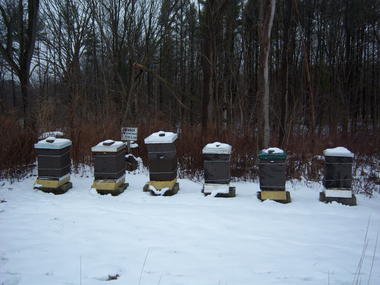Submitted by J. Morgan
Maple sap has been coming in so this means "bud-break" and some of the first pollens (protein) that bees can collect in nature will be next (if not already). This means bees will begin to brood up. Strongest colonies are building up now or will be soon.
The weather has been variable so it's important to ensure there is honey accessible to the cluster so that the bees can more readily move on to it. Perhaps, a candy board would be appropriate if there's not one on already? We should still have some cold weather in front of us... and if bees are building up, that means more food consumption. It's a tricky time of year. On nicer days, take a look in the top and see if your bees are at the top bars, or if they are still in or below some honey frames.
Here is what is happening inside the hive and what the bees do when they are stuck inside a tight cluster for 1-2 weeks on end?
When the ambient temperature drops to 64F (18C), a healthy hive will start to form a cluster or a ball of bees which cling tightly together. As the temperature drops, the cluster will keep contracting; not because the number of bees are decreasing but because they are getting closer together to conserve heat. The following table shows an example of the number of frames that a hive of bees may hypothetically cover as the ambient temperature drops.
| Outside ambient temperature | Number of frames same hive of bees may cover |
| 41F (5C) | 8 - 10 frames |
| 28F ( -2C) | 6 – 8 frames |
| 7F (-14C) | 4 – 6 frames |
| -15F (-26C) | 2 frames |
This contraction explains why the bees can die surrounded by honey during a really cold winter or when over-wintering hives with small populations. The bees simply cannot leave the cluster to get to the food. It also shows that when the temperature fluctuates tremendously as it does in late winter and early spring, it is possible for the bees to spread out as the temperature warms and then accidentally form a tight cluster in the wrong spot, with no nearby food, as it cools.
What a beekeeper should be doing in February:
- This is the prime time for starvation. Check your food sources and add emergency supplies if it is needed. Ideally, you will do this on a warmer day!
- Do the bees have pollen? The queen can start laying eggs in February and pollen will be needed as a brood food source. Be careful about feeding pollen too early though. Doing so can cause a variety of problems. Pollen stimulates brood production and cannot only exhaust food supplies prematurely but also cause the queen to lay eggs beyond the cluster... keeping many bees outside the cluster to keep newly laid eggs warm. In cold temps, bees outside the cluster will die. In addition, pollen causes bees to defecate. Late winter weather may not allow for cleansing flights, increasing the likelihood of dysentery which can quickly lead to a nosema infection.
- Check for dead-outs. If you think the hive is dead, wait for a warmer 40-degree day and peek in the top to make sure. Do autopsies and decide if the hive succumbed to queenlessness, starvation, or disease?
- Clear bottom entrances of dead bees and other debris.
- Count your surviving hives and verify that you have enough honey supers. A good rule of thumb is to have at least 2 supers per hive when the dandelion blooms.
- Is your equipment ready for the year?
- Do you know where you are getting your bees for spring increases or replacement?
- How many swarm traps will you need for spring?
- Keep an eye out for maple tree buds. This will be one of the first pollen sources available. If pollen is actively being brought into the hive, this generally indicates a healthy queen and hive.
- Wax moth activity dramatically picks up as the temperatures rise. Keep an extra eye out for stored frames. Moth crystals (paradichlorobenzene) can be used for control, as well as freezing the frames, or exposing the frames to light.
- If you need to medicate for American Foulbrood, European Foulbrood, or Nosema, start creating your plan because most have a 4 week withdrawal period between treatment and the first marketable nectar flow.
- Spring usually brings some of the wildest and windiest weather. Make sure the lids are secured after you break the seals.
- Brood production also brings mite production. Determine your method for counting mites, your threshold, and control method.
- Go to bee school!
Chime in if I've missed anything. The season will start to speed up from here! Prepare to get into your hives at least once a week if a nice day allows it.



